Learner autonomy in learning English reading skills
Learner autonomy in learning English reading skills is an area not being extensively explored in
Vietnam so far. This study aims at investigating first-year English majored students’ perceptions
of learner autonomy and their practices of learner autonomy in learning reading skills at a
university in Vietnam. Instruments used in the study consist of a questionnaire survey and indepth interviews. The structured questionnaire was administered to 99 participants and an indepth interview was followed up with 11 students who were selected by their mark range from
below average, above average and very good mark. Two instruments were employed to triangulate
data to fulfill the main aim of the research. The results of the survey and the in-depth interview
reveal that almost all the students understood the concept of learner autonomy and were aware of
learning autonomous activities. However, the in-depth interview results indicate that the students
still wanted to be reliant on their teachers in class to gain better results. It is suggested that teachers
should make learners independent in their learning process. In addition, teachers should create
favorable learning environment to facilitate learner autonomy in learning reading skills
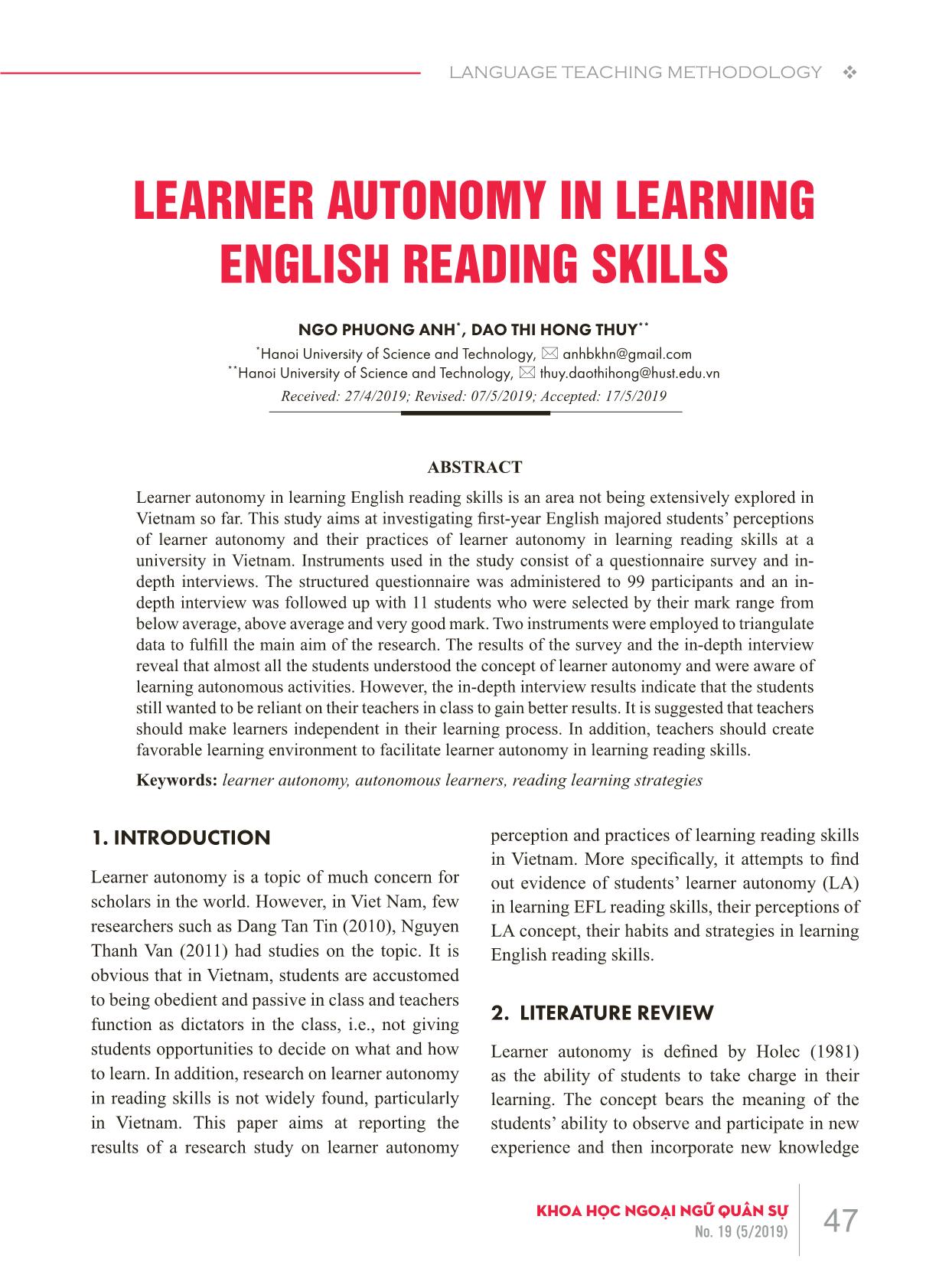
Trang 1
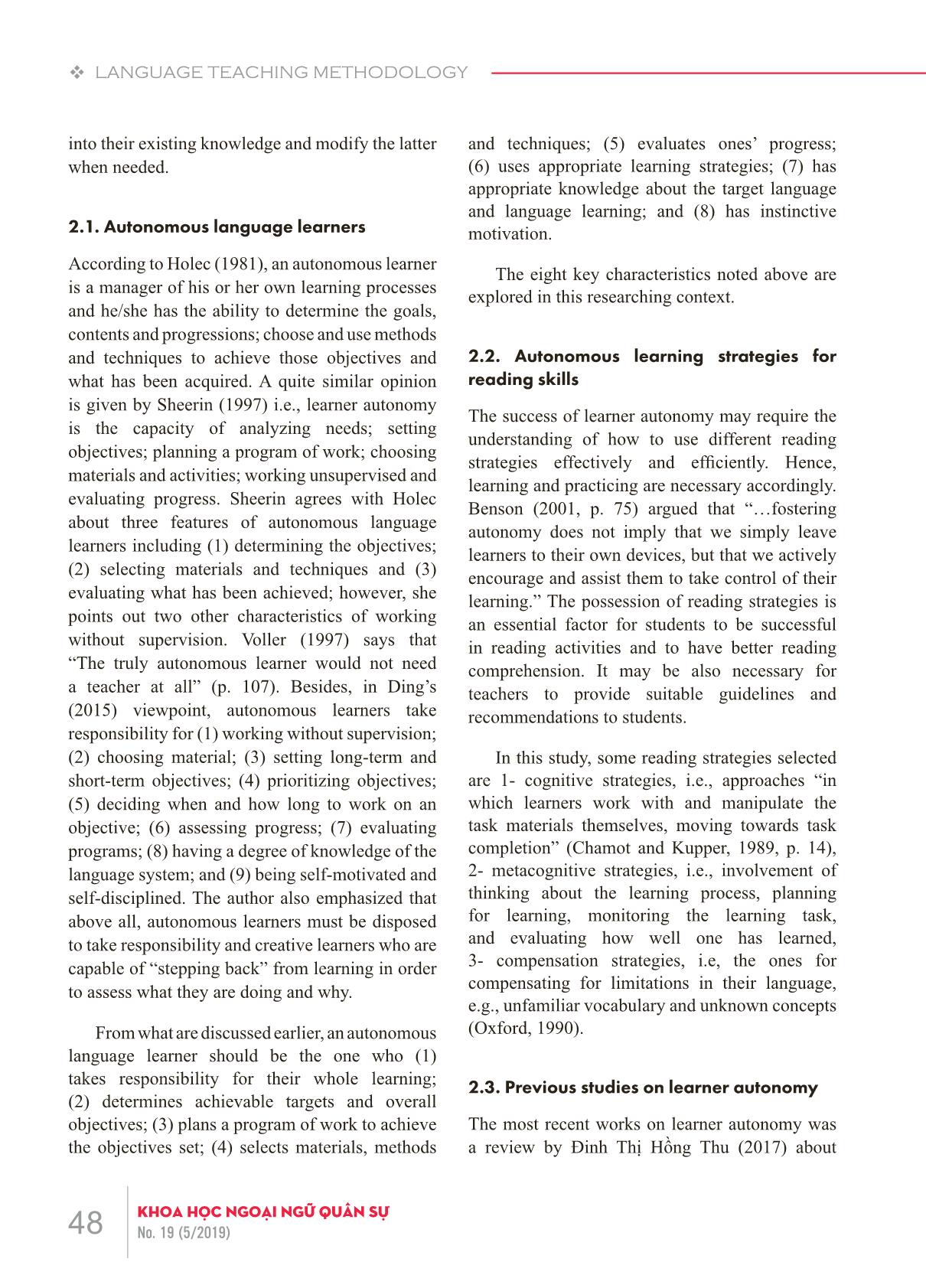
Trang 2
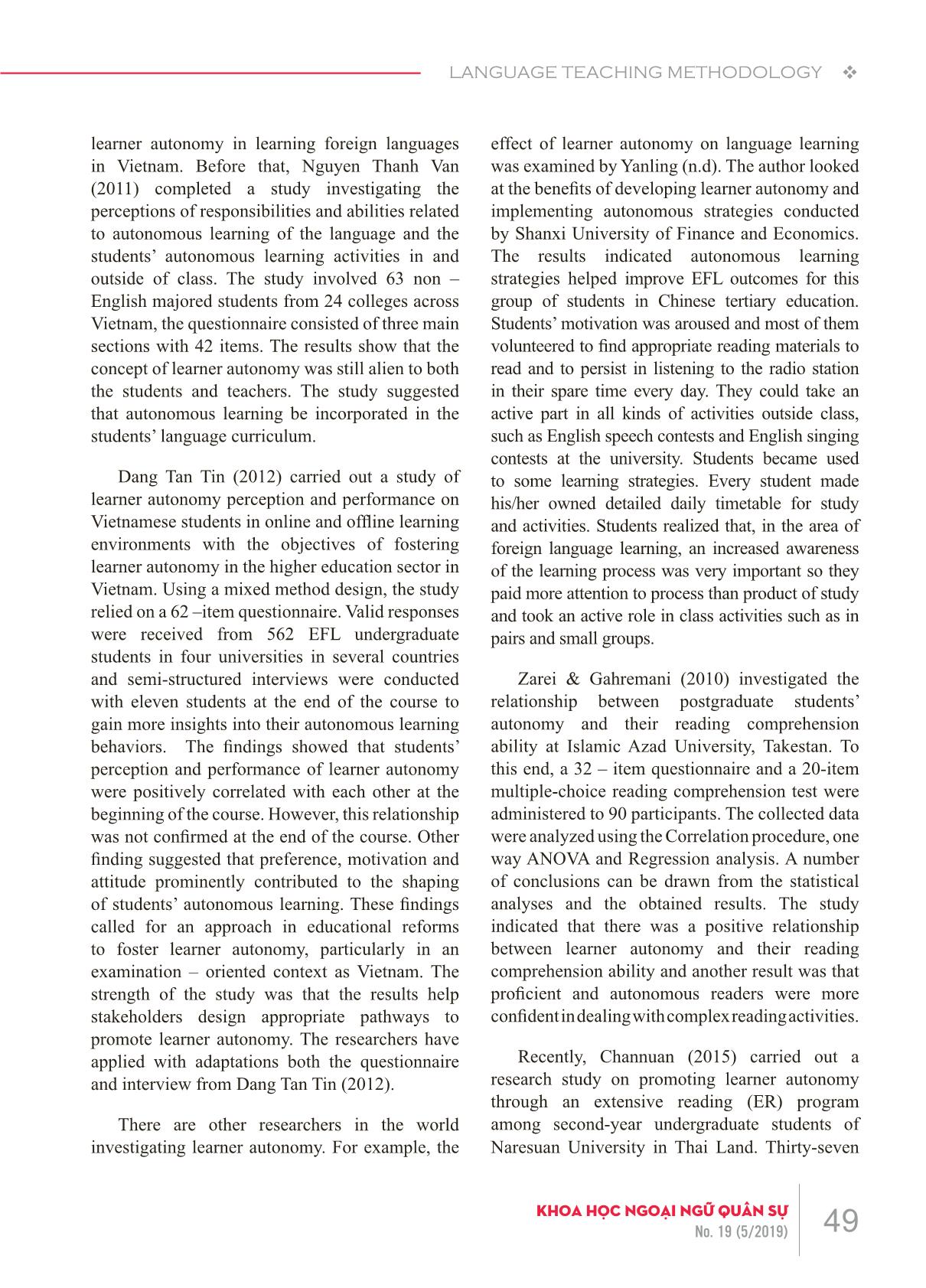
Trang 3
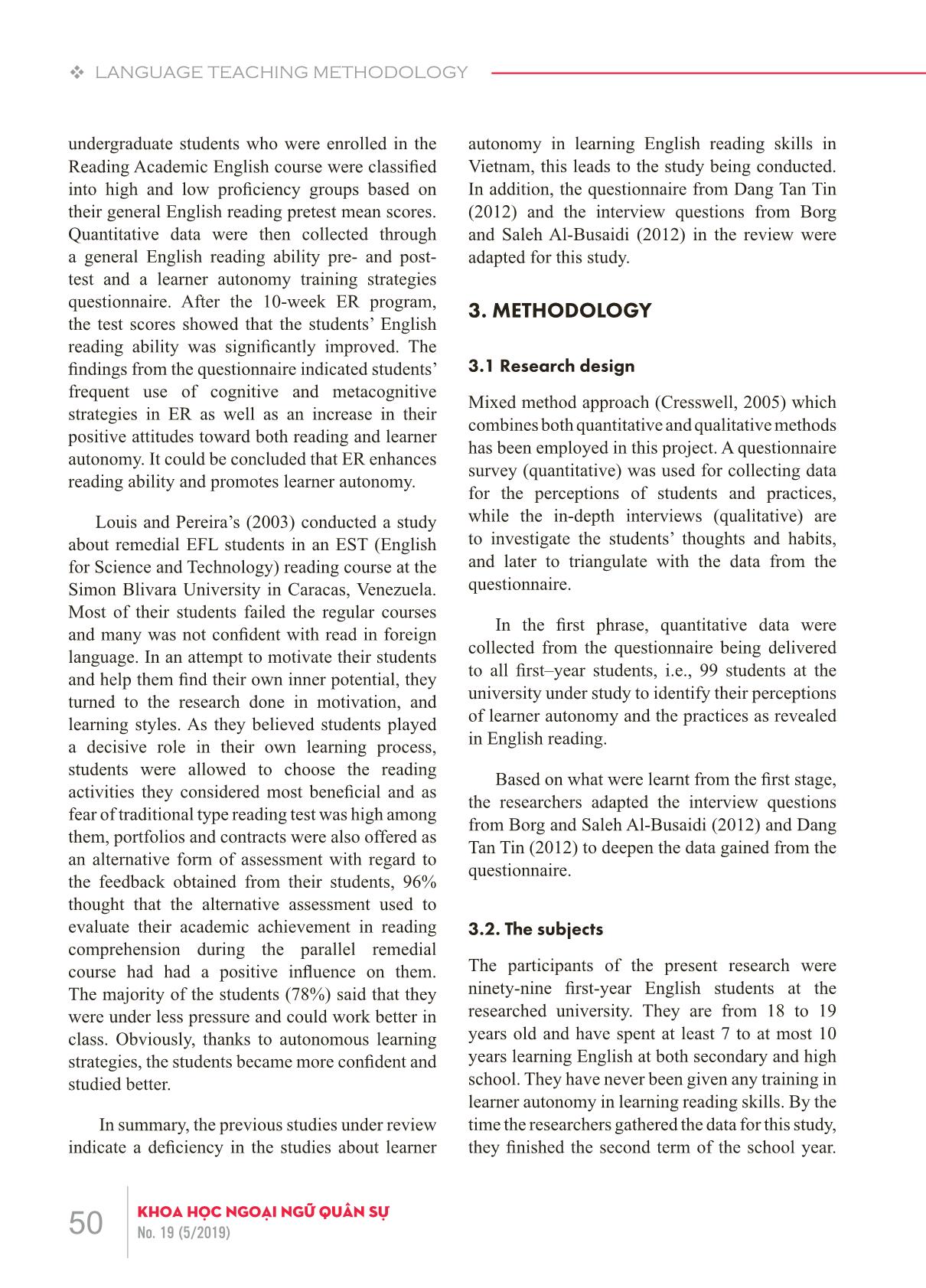
Trang 4
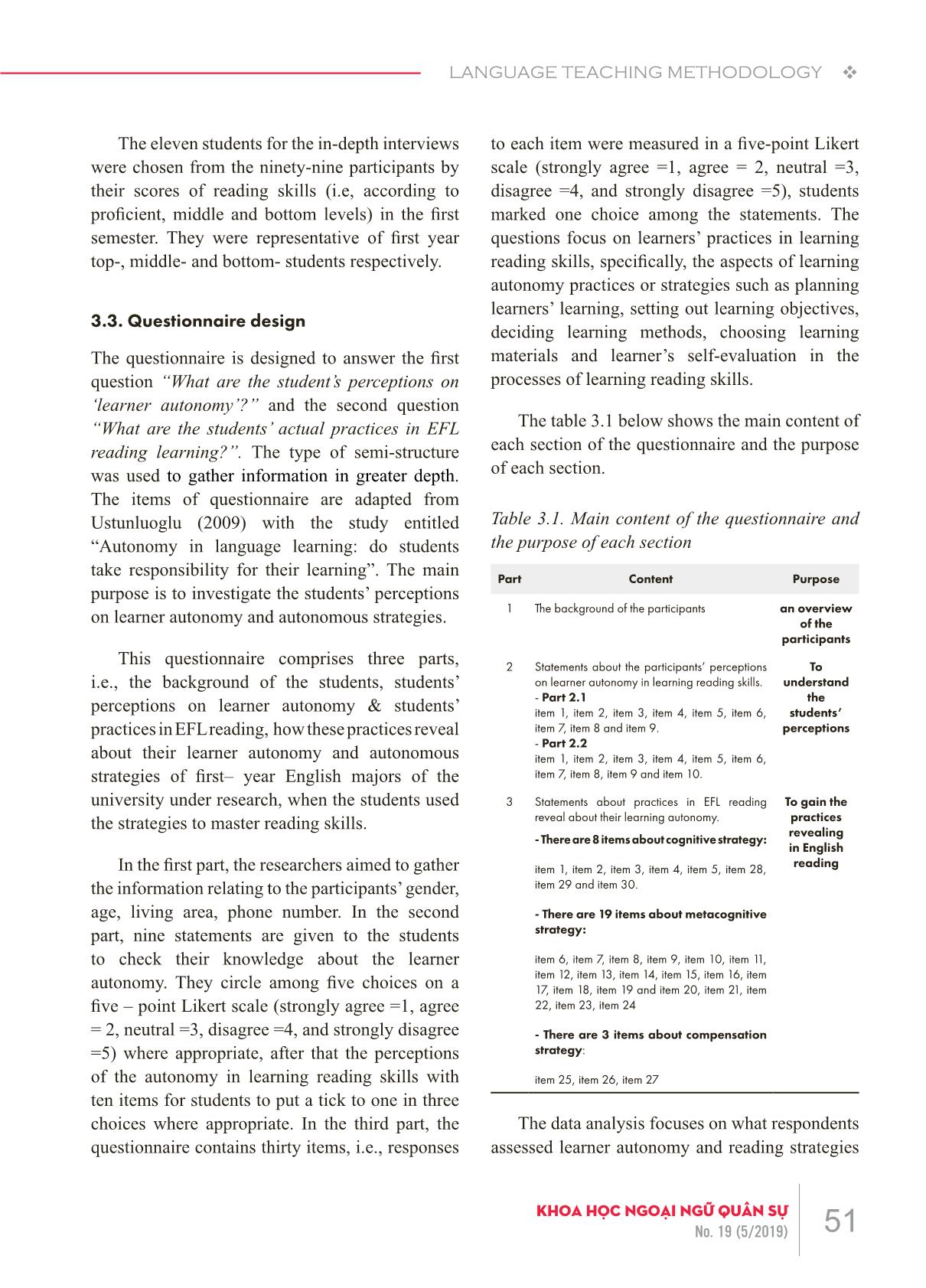
Trang 5

Trang 6

Trang 7
Tóm tắt nội dung tài liệu: Learner autonomy in learning English reading skills

ability and another result was that proficient and autonomous readers were more confident in dealing with complex reading activities. Recently, Channuan (2015) carried out a research study on promoting learner autonomy through an extensive reading (ER) program among second-year undergraduate students of Naresuan University in Thai Land. Thirty-seven 50 KHOA HỌC NGOẠI NGỮ QUÂN SỰNo. 19 (5/2019) v LANGUAGE TEACHING METHODOLOGY undergraduate students who were enrolled in the Reading Academic English course were classified into high and low proficiency groups based on their general English reading pretest mean scores. Quantitative data were then collected through a general English reading ability pre- and post- test and a learner autonomy training strategies questionnaire. After the 10-week ER program, the test scores showed that the students’ English reading ability was significantly improved. The findings from the questionnaire indicated students’ frequent use of cognitive and metacognitive strategies in ER as well as an increase in their positive attitudes toward both reading and learner autonomy. It could be concluded that ER enhances reading ability and promotes learner autonomy. Louis and Pereira’s (2003) conducted a study about remedial EFL students in an EST (English for Science and Technology) reading course at the Simon Blivara University in Caracas, Venezuela. Most of their students failed the regular courses and many was not confident with read in foreign language. In an attempt to motivate their students and help them find their own inner potential, they turned to the research done in motivation, and learning styles. As they believed students played a decisive role in their own learning process, students were allowed to choose the reading activities they considered most beneficial and as fear of traditional type reading test was high among them, portfolios and contracts were also offered as an alternative form of assessment with regard to the feedback obtained from their students, 96% thought that the alternative assessment used to evaluate their academic achievement in reading comprehension during the parallel remedial course had had a positive influence on them. The majority of the students (78%) said that they were under less pressure and could work better in class. Obviously, thanks to autonomous learning strategies, the students became more confident and studied better. In summary, the previous studies under review indicate a deficiency in the studies about learner autonomy in learning English reading skills in Vietnam, this leads to the study being conducted. In addition, the questionnaire from Dang Tan Tin (2012) and the interview questions from Borg and Saleh Al-Busaidi (2012) in the review were adapted for this study. 3. METHODOLOGY 3.1 Research design Mixed method approach (Cresswell, 2005) which combines both quantitative and qualitative methods has been employed in this project. A questionnaire survey (quantitative) was used for collecting data for the perceptions of students and practices, while the in-depth interviews (qualitative) are to investigate the students’ thoughts and habits, and later to triangulate with the data from the questionnaire. In the first phrase, quantitative data were collected from the questionnaire being delivered to all first–year students, i.e., 99 students at the university under study to identify their perceptions of learner autonomy and the practices as revealed in English reading. Based on what were learnt from the first stage, the researchers adapted the interview questions from Borg and Saleh Al-Busaidi (2012) and Dang Tan Tin (2012) to deepen the data gained from the questionnaire. 3.2. The subjects The participants of the present research were ninety-nine first-year English students at the researched university. They are from 18 to 19 years old and have spent at least 7 to at most 10 years learning English at both secondary and high school. They have never been given any training in learner autonomy in learning reading skills. By the time the researchers gathered the data for this study, they finished the second term of the school year. 51KHOA HỌC NGOẠI NGỮ QUÂN SỰNo. 19 (5/2019) LANGUAGE TEACHING METHODOLOGY v The eleven students for the in-depth interviews were chosen from the ninety-nine participants by their scores of reading skills (i.e, according to proficient, middle and bottom levels) in the first semester. They were representative of first year top-, middle- and bottom- students respectively. 3.3. Questionnaire design The questionnaire is designed to answer the first question “What are the student’s perceptions on ‘learner autonomy’?” and the second question “What are the students’ actual practices in EFL reading learning?”. The type of semi-structure was used to gather information in greater depth. The items of questionnaire are adapted from Ustunluoglu (2009) with the study entitled “Autonomy in language learning: do students take responsibility for their learning”. The main purpose is to investigate the students’ perceptions on learner autonomy and autonomous strategies. This questionnaire comprises three parts, i.e., the background of the students, students’ perceptions on learner autonomy & students’ practices in EFL reading, how these practices reveal about their learner autonomy and autonomous strategies of first– year English majors of the university under research, when the students used the strategies to master reading skills. In the first part, the researchers aimed to gather the information relating to the participants’ gender, age, living area, phone number. In the second part, nine statements are given to the students to check their knowledge about the learner autonomy. They circle among five choices on a five – point Likert scale (strongly agree =1, agree = 2, neutral =3, disagree =4, and strongly disagree =5) where appropriate, after that the perceptions of the autonomy in learning reading skills with ten items for students to put a tick to one in three choices where appropriate. In the third part, the questionnaire contains thirty items, i.e., responses to each item were measured in a five-point Likert scale (strongly agree =1, agree = 2, neutral =3, disagree =4, and strongly disagree =5), students marked one choice among the statements. The questions focus on learners’ practices in learning reading skills, specifically, the aspects of learning autonomy practices or strategies such as planning learners’ learning, setting out learning objectives, deciding learning methods, choosing learning materials and learner’s self-evaluation in the processes of learning reading skills. The table 3.1 below shows the main content of each section of the questionnaire and the purpose of each section. Table 3.1. Main content of the questionnaire and the purpose of each section Part Content Purpose 1 The background of the participants an overview of the participants 2 Statements about the participants’ perceptions on learner autonomy in learning reading skills. - Part 2.1 item 1, item 2, item 3, item 4, item 5, item 6, item 7, item 8 and item 9. - Part 2.2 item 1, item 2, item 3, item 4, item 5, item 6, item 7, item 8, item 9 and item 10. To understand the students’ perceptions 3 Statements about practices in EFL reading reveal about their learning autonomy. - There are 8 items about cognitive strategy: item 1, item 2, item 3, item 4, item 5, item 28, item 29 and item 30. - There are 19 items about metacognitive strategy: item 6, item 7, item 8, item 9, item 10, item 11, item 12, item 13, item 14, item 15, item 16, item 17, item 18, item 19 and item 20, item 21, item 22, item 23, item 24 - There are 3 items about compensation strategy: item 25, item 26, item 27 To gain the practices revealing in English reading The data analysis focuses on what respondents assessed learner autonomy and reading strategies 52 KHOA HỌC NGOẠI NGỮ QUÂN SỰNo. 19 (5/2019) v LANGUAGE TEACHING METHODOLOGY in the process of learning reading skills. The questionnaire was distributed face-to-face to the students by the researchers. To make sure that the students answer the questionnaire by themselves, they were asked to complete the questionnaire in the class after a language period in a large lecture hall. To avoid any misunderstanding, we explained and gave clear instruction as well as the purpose of the questionnaire. In addition, we were with the students during the time they filled out the questionnaire to give any necessary explanation or assistance. They were informed that the questionnaire was not a test and there is no right or wrong answer. Therefore, the students just needed to give their own opinion. It took about 15 minutes for the students to complete the questionnaire. After, the data were transferred to a computer and stored in a data file and printed out in hard copy form for analysis. 3.4. In-depth Interviews With the expectation that by using interviews, a researcher can freely use prompts to obtain response clarity or additional information (Burke & Larry, 2000), face-to-face interviews with the researchers ‘were adopted to find out more about students’ perceptions and practices at a university in Vietnam. This instrument is used to triangulate the data about students’ perception and practices which were disclosed via the questionnaire survey. In this research, we chose face-to-face in- depth interviews, a lot of extra information can be added to the verbal answer of the interviewees on a question (Raymond, 2006). Additionally, interview questions are structured and based on the information from the questionnaires, aiming to clarify data from the questionnaire. 3.5. Data Collection procedure The data collection procedure was taken place around one semester at the university under research, which was equivalent to 15 continuous weeks. The questionnaire instrument was used in to investigate the students’ perception about LA at the end of the semester. The questionnaire were delivered to 99 students and the main content of the questionnaire was about the students’ thoughts about LA and their practices of learning reading skills including strategies they used to learn. The questionnaire results were collected and the data were analyzed by the use of SPSS program. Finally, the researchers chose 11 students to take part in an in-depth interview which took place in an empty classroom to avoid disturbance. The interview with each student lasted in two hours (about 11 minutes for each participants). Before being interview fifteen minutes, the participants were given a list of questions and gave any explanation if necessary. In addition, the participants were informed about the purpose as well as the nature of the interview. They were explained that there were no right or wrong answers in the interview and their answers would have no effect on their study results. Therefore, they were encouraged to say what they really did and to answer as honestly as they could. The answers of the interviews were recorded in Vietnamese and translated into English. 3.6. Data analysis procedure The data were analyzed by “qualitative content and analysis” which is “a research method for the subjective interpretation of the content of text data through the systematic classification process of coding and identifying theme and patterns” (Hsieh & Shannon 2005, P.1278). Finally, the steps of data analysis are presented in the following steps. The data analysis consisted of four steps, which are 1) transcribing the data, 2) pre-coding and coding, 3) producing a form of data display, and 4) interpreting the data and drawing conclusions. These four steps were adopted from four phrases of the analytical process suggested by Dornyei (2007, 53KHOA HỌC NGOẠI NGỮ QUÂN SỰNo. 19 (5/2019) LANGUAGE TEACHING METHODOLOGY v pp.246-257). In addition, suggestions on analyzing coded data by Rubin and Rubin (2005, pp.201- 273), Atkinson (1998, pp. 54-58), and Seidman (2006, pp.112-131) were also taken into account. 4. RESULTS AND DISCUSSION 4.1. Results from the questionnaire 4.1.1 Results of the perceptions of the concept “learner autonomy” As can be seen from figure 4.1, the percentage of students understood the concept of the learner autonomy at the beginning of the course occupies 88.3% and the minority (11.7 %) still did not show their awareness of the learner autonomy. 4.1.2 Students’ perception of responsibility. at the beginning of the semester and 8.5% teachers are supposed to be responsible for progress during the semester of learning reading. The results were also illustrated through figure 4.2. 4.1.3. Practices of learning reading skills In order to identify the practices of learning reading skills, the researchers investigated how the participants learnt reading skills, specifically the strategies they used consisting of metacognitive, cognitive and compensation. The cognitive strategies (COG) were used the most frequently by the students. They read the topic which attracted their attention (41.5%) and share the knowledge of science and technology with their classmates (39.4%). Moreover, they also looked for reading resources on the internet (37.2%). It can be seen from the results that the participants chose largely the topics of reading exercises and exploited reading resources on the internet. They spent less time on looking for reading documentary in the library. The results were also shown through figure 4.3. Researched students also used the metacognitive strategies in the process of learning reading skill. The statistics below describes the use of metacognitive strategies (MET) by ninety- nine students, most of MET strategies. Figure 4.1. Student’s perception of the concept ‘learner autonomy’ This graph gives an overview of the students’ perception of responsibility. It is noticeable that the students stick to the evaluation of the students’ progress every week and choosing reading materials for learning to their foremost priority (over 50%) whereas the students describe the teachers’ responsibility such as identifying the weakness of the students in style of reading exercises and choosing outside class tasks to improve reading skills as the most important activity. Only 3.2 % students decide the objectives in learning reading Figure 4.2. Student’s perception of responsibility in learner autonomy
File đính kèm:
 learner_autonomy_in_learning_english_reading_skills.pdf
learner_autonomy_in_learning_english_reading_skills.pdf

